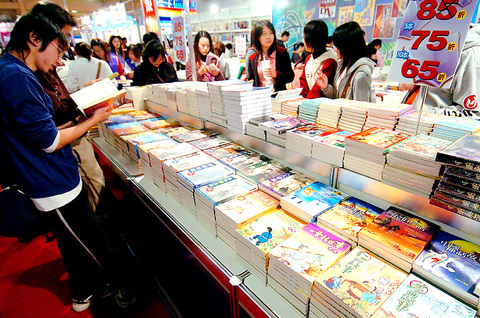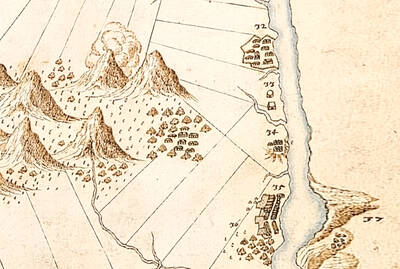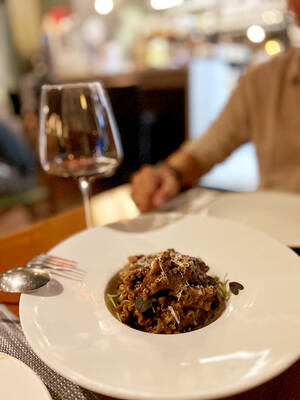First it was cars and high-tech gadgets, then a succession of popular television dramas. Now books are making an impact as "Korea mania" sweeps Taiwan.
With interest in all things South Korean at its highest in years, the Taipei International Book Exhibition has for the first time opened a South Korea pavilion as one of its three major exhibits.

PHOTO: GEORGE TSORNG, TAIPEI TIMES
Soon South Korean authors may join the nation's TV stars in becoming household names across the country, although it is unlikely they will inspire the same fan frenzy as the screen heart-throbs.
"There are good reasons to pick South Korea for one of the three major theme exhibits," said Charlotte Lin, executive director of the Taipei Book Fair Foundation which organizes the book fair.
"They have displayed an outstanding performance on various fronts, and that includes their prosperous publication industry," she said.
The six-day book exhibition, which runs until tomorrow at Taipei's World Trade Center, has drawn 877 publishers from 40 countries to display their publications in 2,099 booths.
But South Korea is proving the major attraction for many of the hundreds of thousands of visitors expected to attend the literary event. Last year's book fair drew about 400,000 visitors.
South Korean-made goods ranging from cars and cellphones to home appliances have been steadily gaining ground in Taiwan in recent years.
But the bout of Korea-mania now sweeping the island is fueled mostly by the success of television serials, which was a key factor behind the pavilion, Lin said.
The popularity of South Korean television programs climaxed last year with the historical drama Dae Jang Geum, set in the Chosun Dynasty about 500 years ago.
On one day in August at least 1.1 million people people tuned into the tale of Korea's first female royal physician Seo Jang-Geum, aired on a local cable TV station, an AC Nielsen survey showed. It was a record audience in Taiwan for a South Korean program.
With that in mind, a one-storey-tall portrait of the program's popular actress Lee Young-ae clad in a traditional Korean dress hangs outside the South Korean pavilion, drawing crowds of fans. The huge poster appeals to Taiwan people to "read Korea, feel Korea."
Inside the pavilion, there are several other huge posters depicting elements of Korean culture such as buildings and ancient artifacts, while hundreds of books are on display.
"I started to show interest in South Korea after a recent tour of the country," said Hsiao Chia-jung, an 18-year-old student.
"Their food is different from ours. My general impression of South Korea was good," she said.
But some book fair-goers doubted whether Korea-mania could extend into literature.
"These books are all Greek to me," said one woman, looking at the Korean-language texts.
To help overcome the language barrier, two local publishers have translated into Chinese two novels by Lee Mun-yul, the internationally best-known South Korean writer.
The Chinese editions of Our Twisted Hero and The Son of Man hit the market Wednesday after Lee met with his readers at the fairground.
Our Twisted Hero, which won its author Korea's Lee Sang Literature Prize in 1987, criticizes the then authoritarian government, while The Son of Man tells of a young man in the search of his own soul.
"The chance of Lee becoming a popular writer here is high," said Huang Yeh-fang from the Taipei-headquartered Linking Publishing Co, which published the The Son of Man.
"He is one of the few South Korean writers whose works have not only sold well but also have high literary value," Huang said.
South Korean publishers have also sold copyright of some books -- notably children's books -- to their Taiwanese counterparts.
"Over the past four years, we've sold the copyrights of 50 children books to the publishers here for sales in Taiwan," said Sean Choi, an official with Seoul-based Kyowon Co.
Analysts said the bout of "Korean-mania" has helped disperse Taiwanese people's resentment of South Korea sparked when Seoul, a longstanding ally of Taipei during the Cold War era, switched its diplomatic recognition from Taipei to Beijing in 1992.

Last week gave us the droll little comedy of People’s Republic of China’s (PRC) consul general in Osaka posting a threat on X in response to Japanese Prime Minister Sanae Takaichi saying to the Diet that a Chinese attack on Taiwan may be an “existential threat” to Japan. That would allow Japanese Self Defence Forces to respond militarily. The PRC representative then said that if a “filthy neck sticks itself in uninvited, we will cut it off without a moment’s hesitation. Are you prepared for that?” This was widely, and probably deliberately, construed as a threat to behead Takaichi, though it

Nov. 17 to Nov. 23 When Kanori Ino surveyed Taipei’s Indigenous settlements in 1896, he found a culture that was fading. Although there was still a “clear line of distinction” between the Ketagalan people and the neighboring Han settlers that had been arriving over the previous 200 years, the former had largely adopted the customs and language of the latter. “Fortunately, some elders still remember their past customs and language. But if we do not hurry and record them now, future researchers will have nothing left but to weep amid the ruins of Indigenous settlements,” he wrote in the Journal of

Even after years in business, weekend tables here can be booked out a month in advance. The price point far exceeds its competitors. Granted, expectations are soaringly high, but something here failed to hit the high notes. There are a few telltale signs that a restaurant relies solely on outstanding food to create the experience, no gimmicks or distractions needed. La Mole is such a restaurant. The atmosphere is food-forward, with an open kitchen center stage. Our tables are simple; no candles, no dim lighting, no ambient music. The menu is brief, and our waiter directs most

Seven hundred job applications. One interview. Marco Mascaro arrived in Taiwan last year with a PhD in engineering physics and years of experience at a European research center. He thought his Gold Card would guarantee him a foothold in Taiwan’s job market. “It’s marketed as if Taiwan really needs you,” the 33-year-old Italian says. “The reality is that companies here don’t really need us.” The Employment Gold Card was designed to fix Taiwan’s labor shortage by offering foreign professionals a combined resident visa and open work permit valid for three years. But for many, like Mascaro, the welcome mat ends at the door. A